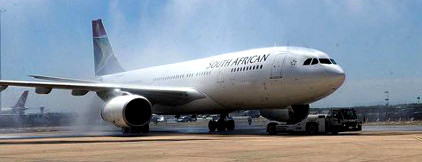Let me just say it straight up — neither President Jacob Zuma nor SAA board chairperson Dudu Myeni are to be blamed for the operational unprofitability of SAA. South Africans are currently rallying together in the #ZumaMustFall campaign, which was in part triggered by the removal of Nhlanhla Nene as finance minister, allegedly due to his stance on the SAA A320/A330 swap transaction.
Within the past weeks, Ernst & Young tabled a damning forensic report detailing weak financial controls at the airline, stating that up to 60% of procurement and contracting was improperly negotiated, poorly contracted and weakly managed. Public perception has decided that corruption and cronyism is the cause of the airline’s woes. I hope to unravel the causes of unprofitability at SAA from an aeronautical perspective.
In financial year 2001/2002, SAA was operating a total of 62 aircraft (Boeing 737s and 747s) Today, SAA operates around 50 aircraft — a mix of widebody aircraft (Airbus A340s and A330s), with the narrow body fleet comprising Airbus A320s and Boeing 737s.
When SAA made the decision to replace the ageing Boeing 747 fleet in the early 2000s, it was premised on the fact that the four-engined replacement, the A340 family, would offer more value for money based on fuel efficiency over the Boeing fleet. Also, choosing a four-engined aircraft over a twin engine made sense economically due to SAA flying intercontinental, transoceanic routes. Extended-range Twin-engine Operation Performance Standards (Etops) regulations for twin engine aircraft operating out of Johannesburg would have prohibited certain routes that did not have the requisite airport diversion radius of 90 minutes. These rules did not apply to the four-engined A340s selected by SAA.

Aircraft design is usually a multi-disciplinary effort, with diverse specialists coming together as a team as there are many complex and often conflicting requirements to be considered. Fuel efficiency has always been a consideration, but for a long time, it was never really a design constraint. The higher-speed, longer-range philosophy proved to work well as fuel was inexpensive, the design would result in favourable economic returns since crew costs and amortisation of capital investment in the aircraft could be spread over more seat miles flown per day, despite higher fuel consumption.
In running an airline, fuel costs are amongst the top operating expenses. Now that fuel has tripled in price within the decade, it can account for half of an airline’s operating costs. In today’s economic climate, fuel efficiency has become the name of the game. Any savings in fuel costs, over the long term, add up for an airline.
At the time of SAA choosing the A340s, the average price of Brent crude was about $20 a barrel. In 2014, this had soared to an average of $108 a barrel, according to the latest SAA annual report. This obviously would have devastating effects for an airline operating a four-engine widebody fleet. The economics of operations are no longer favourable based on the prevailing market conditions. Airlines began to opt for twin engine Airbus A330s and Boeing 777s instead of the A340. The A340 programme officially came to an end in 2011, with Airbus citing changing market dynamics as the reason behind the end of production. Airline giants Lufthansa and Emirates are phasing out the A340s in their fleet and Singapore Airlines has already retired its A340 fleet.
This has been a significant contributing factor to the losses reported by SAA on its international routes. SAA has consistently noted the operating fleet and rising oil price as an area of concern for the business. By replacing the A340 fleet with more fuel-efficient, twin-engined aircraft with latest Etops certification, SAA can begin to realise a profit in segments of its operations. SAA has already made changes to its routes — it has scrutinised and scrapped a number of loss-making routes (Kigali, Bujumbura, Buenos Aires, Mumbai, Beijing).
There is light at the end of the tunnel for an airline like SAA looking to replace its uneconomic and inappropriate fleet. Advancements in technology have allowed aircraft similar in size and specification to the A340 to be powered by two engines instead of four. Aerodynamic efficiency, weight efficiency, the use of composite materials, cabin layout and seating density, engine efficiency and aircraft fuel burn — driven by operations/mission profile (payload, range, speed and flight levels) have allowed the newer twin engine jets to replace their older predecessors.
The current drop in oil price compared to recent years, has given SAA some breathing space to consider a more permanent solution to the widebody long-haul fleet renewal. Swapping out ten A320s for five A330s makes sense for now. A portion of the current A340 fleet lease has been extended, allowing operations to continue, although the risk of rising oil prices could very well destabilise SAA’s path to profitability.
The bottom line is that Zuma and Myeni had nothing to do with aircraft designers selecting parameters to optimise in the 1980s and 1990s. The conditions that made the A340 acquisition suitable for SAA no longer exist. The cost benefit of a long-range, transoceanic design can no longer be realised, and unfortunately, the patience of the South African public is wearing thin. In this regard, Zuma and Myeni are easy targets for the average citizen who may not appreciate the multiple layers of complexity behind operating a fleet of large transport aircraft. The findings which Ernst & Young have brought to light (and their implications for the airline) deserve more attention than further flogging the already dead horse of operational unprofitability due to fleet legacy.



